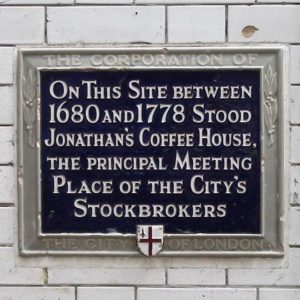The London coffeehouses of the 17th and 18th centuries were the engines of creation that helped drive the Enlightenment, the European intellectual movement that emphasized reason and individualism rather than tradition. Their history is a fascinating one.
Modern-day coffee shops such as Starbucks, Costa Coffee, and Caffè Nero have their roots in 17th and 18th-century London coffeehouses. Still, those old coffeehouses were quite unlike the establishments we know and love today.
The first European coffeehouse opened in Venice in 1645, and it became popular throughout Europe during the late 17th century.
The first coffeehouse was opened in America in 1689 and spread worldwide.
In 1652 Pasqua Rosée, a Greek, opened the first coffee stall in St Michael’s Cornhill’s churchyard in the City of London.
17th-century coffee was pretty foul compared to today’s coffee, but its caffeine was an addictive stimulant.
Soon, coffeehouses were commonplace. Ten years later, in 1663, there were over 80 coffeehouses within the City, and by the start of the eighteenth century, this number had grown to over 500.
Coffeehouses were places where men, and only men, went to meet each other and have conversations.

These men were often strangers, and conversations with strangers were a founding principle and the lifeblood of coffee houses.
Before coffeehouses, men met in alehouses to discuss, exchange ideas, and do business. Still, thanks to the ale, such venues were noisy, often rowdy places that were not conducive to conversations.
On the other hand, coffeehouses were quieter, more sedate venues where people, again only men, I am sorry to say, could engage in more serious conversation.
Any man could gain admittance to a coffeehouse by purchasing a cup of coffee for one penny. Here, he could drink coffee, smoke, read the newsletters, or join one of the conversational groups. Therefore, it is not too surprising that such coffeehouses became known as penny universities.
These London coffeehouses of the 17th and 18th centuries were the engines of creation that helped drive the Enlightenment, the European intellectual movement that emphasized reason and individualism rather than tradition.
Different districts of London housed coffeehouses that catered to distinctive professions.
Coffeehouses near the Royal Exchange in the City were for businessmen. Politicians frequented those in the neighborhood of Westminster and St James, and clergymen and theologians patronized those near St Paul’s Cathedral.
In some ways, they were early forms of what we would call communities of practice today.
The early London Coffeehouses

Many British institutions have their roots in these early coffeehouses.
Established in 1660, members of the Royal Society met in coffeehouses to discuss, debate, and exchange knowledge. Isaac Newton even once dissected a dolphin on the table of the Grecian Coffeehouse.
The London Stock Exchange evolved from Jonathan’s Coffee-House, a coffeehouse founded by Jonathan Miles in Exchange Alley around 1680.
Lloyd’s Coffee House, opened by Edward Lloyd on Tower Street in around 1688, was frequented by members of the shipping community, such as merchants, sea captains, and shipowners. It was also a place to discuss insurance deals. The dealings led to the establishment of the insurance market Lloyd’s of London and Lloyd’s Register.
William Shipley founded the Royal Society of Arts (RSA) in 1754 and held its first meeting at Rawthmell’s Coffee House in Covent Garden.
Sotheby’s and Christie’s auction houses also have their origins in coffeehouses.
The lost world of the London coffeehouse | Matthew GreenModern Day Coffee Shops
The early coffeehouses were far removed from today’s coffee shops, where people sit glued to their laptops or smartphones and rarely talk with each other, never mind strangers.
They were places where people went to learn the latest news and actively engaged with each other in gossip, animated discussion, and fierce debate on a broad range of topics from politics to religion to science.
They were social communities of sorts. They were the Internet of their day.
Things have changed over 350 years. Today, we get instant news from around the globe delivered to us on our smartphones, and we can discuss and debate in a broad spectrum of online forums.
However, these online conversations are not the same. They are not real conversations – they lack so much – the intensity, the vigor, the passion, and the humor.
I’d like to see the return of these old coffeehouses—not for the vile coffee of the day but for real face-to-face conversation. I’d love to walk into a Starbucks, sit down next to a total stranger, and yell out, “Your Servant Sir, what news from Tripoli?”
Resources
Posts that link to this post
- History of Conversation The changing face of conversation through the ages
- The Enlightenment The Age of Reason
POST NAVIGATION
CHAPTER NAVIGATION
Tags: coffeehouse (4) | conversational space (11) | London coffeehouses (6) | Royal Society of Arts (3) | talk with strangers (13) | The Enlightenment (28)
SEARCH
Blook SearchGoogle Web Search
Photo Credits: David Gurteen (Public Domain) | David Gurteen (Public Domain)
If you enjoy my work and find it valuable, please consider giving me a little support. Your donation will help cover some of my website hosting expenses.
Make a donation


Hello David, What I have always wondered is ‘Where did the old coffee houses all go?”
Warm regards,
Alison Donaldson
I had wondered that Alison. This is what Wikipedia says:
https://en.wikipedia.org/wiki/English_coffeehouses_in_the_17th_and_18th_centuries#Decline
best wishes David